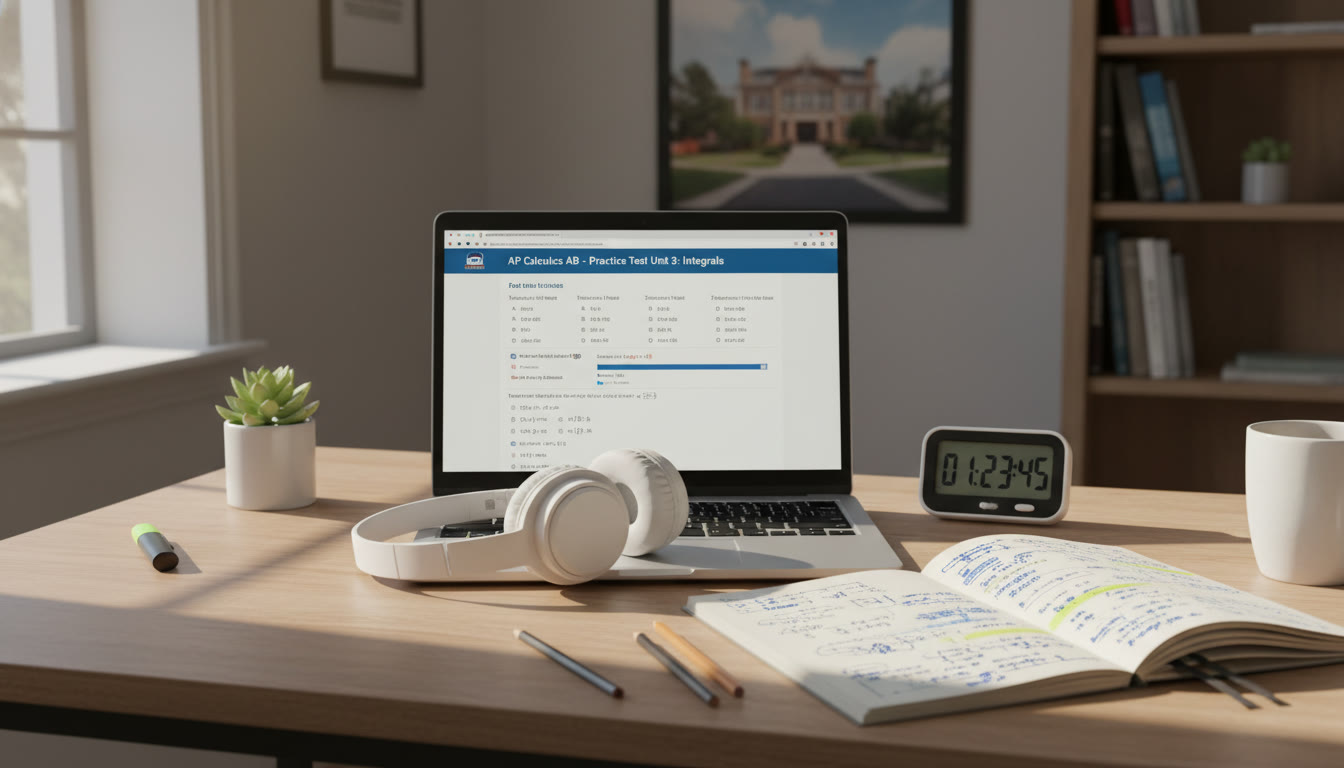Why a Practice-Test Protocol for Language Sections Matters
If you want to turn anxiety into confidence for the AP language exams, you need more than last-minute flashcards and a handful of sample questions. You need a practice-test protocol — a repeatable, realistic way to simulate test day for the language sections. When done well, practice tests do three things: they reveal what you don’t know, train the timing and stamina needed for long reading-and-writing sessions, and build the kind of calm focus that separates a good score from a great one.
Who this guide is for
This post is written for students preparing the Language sections of AP English Language and Composition (and other AP language-style assessments). Whether you’re practicing multiple choice reading questions, writing timed essays, or preparing for the new digital format, the steps below will help you plan, execute, and learn from realistic practice tests.

Overview: The Two Language Section Types
Before you design a protocol, be crystal clear about what you’re simulating. AP language exams typically include two overarching elements:
- Multiple-choice/Reading: Long and short nonfiction passages, paired questions that test reading comprehension, rhetorical analysis, and synthesis of ideas.
- Free-response/Writing: Timed essays that ask you to craft an argument, analyze rhetorical choices, or synthesize multiple sources into a coherent position.
Each section requires different preparation and focus. Your practice-test protocol should reproduce the volume, timing, and cognitive load of both.
Setting Up a Realistic Practice Test
One of the biggest mistakes students make is practicing in a low-stakes, interrupted environment. A realistic practice test has three core elements: the right materials, the right environment, and strict timing.
Materials you’ll need
- Authentic practice questions or past free-response prompts (from official sources or AP Classroom).
- A digital device and/or paper, depending on whether you’re simulating a digital exam or a paper-style testing situation.
- A stopwatch or countdown timer — visible but not distracting.
- Answer sheet or a blank document to write essays exactly like test conditions (no external help, no internet).
- Quiet room, clear desk or table, and any allowed resources (pencils, eraser, scrap paper).
Environment and mindset
Treat practice like the real exam: silence your phone in another room, remove music or background noise unless you always study with a particular low-volume white-noise track, and tell family or roommates that you are unavailable. Sit in a chair you can use for extended periods; the physical experience of a three-hour stretch matters. If you’ll take the real test on a laptop in a specific application, practice with the same app or at least create a digital environment that mimics it.
Timing cheat sheet
Map out the clock before you start. A straightforward timing layout for a comprehensive language practice session could look like this:
| Section | Simulated Time | Purpose |
|---|---|---|
| Warm-up reading (short passage practice) | 15 minutes | Get into reading mode and calibrate annotation speed |
| Multiple-choice block | 60–75 minutes | Practice pacing across multiple passages and question types |
| Break | 10–15 minutes | Reset focus and reduce fatigue (practice shorter breaks like real test day) |
| Free-response essays (timed) | 90–135 minutes | Complete timed essays with real prompts and a 15-minute reading period where applicable |
| Reflection and scoring | 30–45 minutes | Self-score or review with a rubric, note errors, and set action steps |
Section-by-Section Protocols
Multiple-Choice / Reading: How to simulate and learn
Goal: build speed without sacrificing comprehension. You want to be able to read closely, find evidence, and answer questions with precision.
- Annotation method: Use a two-layer marking system. First, underline or highlight the thesis and topic sentences. Second, use brief margin notes to tag rhetorical moves (e.g., “contrast”, “example”, “causal”). Keep margin notes to 1–3 words so you don’t slow down the reading.
- Question triage: For each passage, take the first pass to answer straightforward questions (detail and main idea). Flag harder questions for a second pass rather than getting stuck for too long.
- Evidence-first answers: When you select an answer, quickly jot one-line evidence that convinced you (e.g., “para3: counterargument + example”). This improves accuracy and trains evidence-based reading.
- Time checkpoints: If you have 60 minutes for five passages, aim to finish each passage + questions in 11 minutes with a 5–10 minute buffer for review at the end.
Free Response / Writing: How to simulate and improve
Goal: write clear, well-structured essays under time pressure that directly address the prompt and use evidence effectively.
- Pre-write quickly: Use a 5–8 minute planning window to map your thesis, topic sentences, and two or three supporting pieces of evidence or textual references. A short plan saves time and reduces wandering paragraphs.
- Structure anchor: Always follow a clear paragraph pattern: claim, evidence, explanation, link back to thesis. Repeat this pattern for body paragraphs and conclude by elevating the argument — don’t just restate the thesis.
- Time allocation: For a 40–50 minute essay, allocate roughly 8 minutes for planning, 30–36 for writing, and 4–6 for a quick revision. For synthesis prompts that require multiple sources, spend extra time ensuring you cite and integrate sources properly.
- Rubric alignment: After writing, score your essay with the official rubric (or a teacher-provided rubric). Be brutally honest — if your essay lost points for weak evidence, note that and make it a focus of the next practice.
Scoring and Feedback: Turning Errors into a Plan
Practice without feedback is busywork. To make practice tests transformative, you must score them and turn mistakes into actions.
Self-scoring checklist
- Multiple Choice: Track the types of questions you missed (detail, inference, vocabulary in context, rhetorical purpose). Which patterns appear most often?
- Essays: Use the rubric to score claims, evidence, analysis, and sophistication. Where did you lose the most points — organization, evidence, or analysis depth?
- Timing: Note where you ran out of time. Did multiple-choice slow down because of complex passages? Did essays suffer from insufficient planning?
Actionable review steps
- Create a two-week micro-plan focusing on your top three weaknesses discovered in the practice test.
- For reading errors: practice targeted short-passage drills that emphasize the specific skill (e.g., inference or rhetorical purpose).
- For writing errors: rewrite a past essay incorporating targeted feedback, or exchange essays with a peer and compare rubric-based scores.
- Re-test: After two focused practice sessions, take another full protocol test to measure improvement.
Building Stamina and Managing Stress
Language sections ask for sustained concentration. Stamina is a skill you build by practicing under realistic conditions.
Micro-habits for stamina
- Gradually increase practice-test length. Don’t jump from 30 minutes to three hours overnight.
- Practice short, timed reading sessions daily (20–30 minutes) and a full-length practice test once every 7–10 days.
- Use deliberate rest: a real timed break in the middle of a long practice session helps you reset and simulates test-day conditions.
Mindset and stress protocol
Before you start, take two minutes of focused breathing. After each section, do a 30-second physical reset — stretch shoulders, roll your neck — to preserve mental energy. Post-test, write a one-paragraph reflection: what felt good, what crashed, and the main insight you’ll act on next.

Use of Technology and Resources
Digital practice is increasingly common. If your exam will be delivered digitally, practice with devices and apps that mimic the real environment. That said, don’t ignore paper practice: handwriting essays can strengthen clarity and planning because it forces you to be concise and deliberate.
When to simulate the digital interface
- If your exam will use a specific testing app, download any official test preview apps and spend at least one practice session using them.
- Learn keyboard shortcuts for quick navigation and practice typing essays at your test pace so you know how many words you can reliably write in 30–45 minutes.
Leveraging Tutoring and Personalized Support
Targeted human feedback accelerates growth. If you’re stuck on pattern errors — like weak evidence usage or a slow reading pace — a few guided sessions can transform your practice time from “hopeful” to “strategic.”
How personalized tutoring helps (when used wisely)
- 1-on-1 guidance to identify stubborn blind spots — sometimes an outside observer spots habits you miss, like repeating the prompt word-for-word instead of synthesizing it.
- Tailored study plans that take your practice-test results and allocate focused drills and mini-sessions on weak skills.
- Expert tutors can model strong annotations, efficient triage strategies for multiple-choice, and clear essay blueprints you can reuse under pressure.
- AI-driven insights (when available through authorized services) can track your progress across dozens of practice tests and suggest adaptive practice paths that optimize time spent on each skill.
For many students, Sparkl’s personalized tutoring offers a mix of these benefits: one-on-one guidance, tailored study plans, expert tutors, and AI-driven insights that help prioritize practice. If you choose to work with a tutor, use your practice-test reports to make sessions maximally efficient — bring a scored test and specific questions you want dissected.
Designing a Repetition Schedule: How Often to Practice
Quality beats quantity — but you still need consistent repetition. Here’s a suggested cadence that balances focused practice with recovery and learning consolidation.
| Timeframe | Activity | Why it works |
|---|---|---|
| Daily (20–40 minutes) | Short timed drills: one passage or one essay planning and outline | Builds micro-skills: focused reading, quick outlining, vocabulary-in-context practice |
| Weekly (1 full protocol) | Simulate a full language-section practice test with strict timing and scoring | Maintains test-readiness and identifies macro-level weaknesses |
| Biweekly or Monthly | Deep review sessions with a tutor or teacher | Targets persistent errors and checks long-term progress |
Concrete Example: One Practice-Test Walkthrough
Imagine you have 3 hours set aside on a Saturday. Here’s how to spend it:
- 00:00–00:10 — Quick warm-up: two short passage questions to focus reading speed.
- 00:10–01:20 — Multiple-choice block: five passages, strict timing, mark every question with a one-line evidence note.
- 01:20–01:30 — Break: stretch, hydrate, no screens.
- 01:30–02:45 — Free-response: 15-minute reading/planning for the synthesis task, then write all required essays within the allotted time; follow rubric-based structure.
- 02:45–03:15 — Self-scoring and reflection: mark MCQs, score essays, identify top three areas to target in the next week.
At the end of the session, record three concrete next steps: e.g., “Do 10 inference questions daily,” “Practice thesis statements for 20 minutes every other day,” “Schedule a 1-on-1 with a tutor to review evidence usage.”
Common Pitfalls and How to Avoid Them
- Over-correcting based on one practice test: Individual tests vary. Don’t throw out your plan after a single bad session; look for consistent patterns across multiple tests.
- Ignoring timing practice: Many students can analyze well on untimed practice but collapse under the clock. Treat time as a non-negotiable constraint.
- Skipping feedback: If you don’t score and analyze, you’ll repeat the same mistakes. Even a quick rubric-based self-score is better than no feedback.
- Practicing passive review: Simply reading model essays is less effective than active writing and scoring. Actively produce under timed conditions.
Final Checklist Before Your Next Practice Test
- I’ve downloaded or printed authentic practice prompts and multiple-choice passages.
- I’ve scheduled a quiet time block and prepared my materials.
- I will simulate timing exactly and eliminate phone distractions.
- I will score honestly and create a short action plan from results.
- I’ve identified when I’ll revisit the same protocol to measure improvement.
Closing Notes: Make Practice Predictable, Not Boring
Good practice is deliberate and slightly uncomfortable — exactly what you’ll face on test day. The protocol shared here will help you make your practice predictable so that performance becomes a function of training, not luck. Keep sessions focused, score honestly, and iterate on your plan. If you find recurring weak spots, a few targeted tutoring sessions — such as Sparkl’s personalized 1-on-1 guidance — can compress months of progress into a few weeks by offering tailored study plans, expert feedback, and data-driven insights. Use help strategically, and keep the control in your hands: practice, reflect, adapt, and repeat.
One last thought
Practice tests are not a final exam of your current abilities — they are experiments. Treat each test as data you collect about how to study smarter. That mindset turns frustration into fuel, and little by little, your practice becomes performance.
Good luck — and remember: consistency, honest feedback, and well-designed practice beats last-minute cramming every time.
























No Comments
Leave a comment Cancel